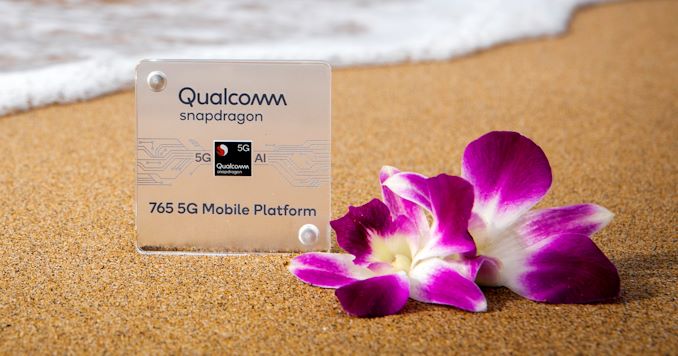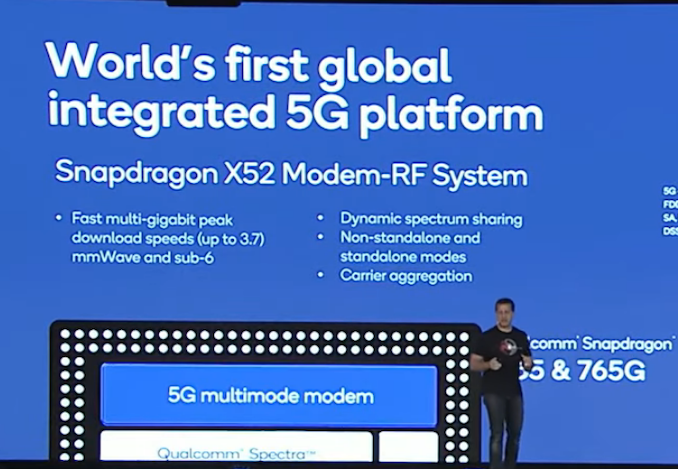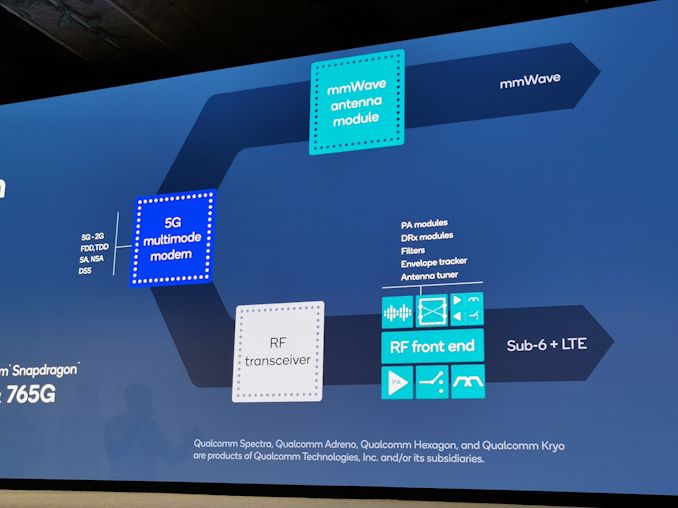Qualcomm Goes For The Mid-Range: Snapdragon 765 and 765G
by Dr. Ian Cutress on December 3, 2019 8:15 PM EST
The first day of Qualcomm’s annual Snapdragon Tech Summit is often the teaser day: a slow entry into the rest of the event where the technical aspects of the announcements are disclosed. What the teaser day does is often give us the names of Qualcomm’s future products, and today we have that – one of the announcements was the name of the Snapdragon 765 and 765G chips, with an integrated 5G modem on the silicon. We’ll get more details about the hardware tomorrow, but there’s a few things today that have been disclosed and are worth covering.
Qualcomm’s 700-series chips are often targeted more at the mid-upper smartphone market: where the 800-series goes into the flagships, the 700 covers the slightly cheaper devices that are more price sensitive but with most of the same features. This year the Snapdragon 765 and 765G are set to offer a slightly cut down version of the new Snapdragon 865 (also announced today, with more details tomorrow), but it differs in one key aspect in the fact that it has an integrated 5G modem.
While Qualcomm has the X55 external modem for the high performance parts, Qualcomm has integrated what it calls the ‘X52’ 5G modem platform into the 765 and 765G. This modem is still quite powerful according to Qualcomm’s statements: up to 3.7 Gbps download speeds, support for mmWave, Sub 6 GHz, Dynamic Spectrum Sharing, NSA, SA, and carrier aggregation. As the modem is on the same silicon as the core, it helps with integration, ensuring that every 765 device will always have a 5G modem, and can also help with power management as well.
For both mmWave and Sub 6 GHz support in the phone, it will require the OEM to decide to add in the correct antenna placement, although Sub 6 GHz and LTE use the same RF front-end, so we expect that only mmWave support would be OEM decided. Qualcomm has designed these chips to be ‘global’ and support as much of the current and future 5G infrastructure as possible.
Technically Qualcomm didn’t really give any more details than that. However, we did notice that for a split second that they did show this slide during the presentation, perhaps in error, at time stamp 46m14:
Here we see that the 765 and 765G will have a Qualcomm Spectra 355 ISP, an Adreno 620 GPU, and a Hexagon 696 DSP. None of these we’ve heard of before, and so are new and the specification are unknown (apparently the Adreno 620 popped up online as part of an unannounced Snapdragon 735 part), so capabilities are a question mark. The difference between 765 amd 765G also hasn’t been disclosed yet, and that ‘G’ doesn’t mean 5G, as both chips have the modem inside.
So ultimately this SoC is going to be pushing 5G connectivity into the hands of more people who can’t afford flagships, but still want a high-end phone. We are getting more details about the chip tomorrow during the technical presentations.













12 Comments
View All Comments
danielfranklin - Tuesday, December 3, 2019 - link
Sounds like its probably a higher clocked SD735, which should hopefully have a couple of A76 based cores in it.Im so sick of the distance between Qualcomm's flagship chip and their :mid-range".
Last year we finally saw a couple of larger CPU cores in their top mid-range SOCs, but they also seemed to fail to get them into many devices. The GPUs below the flagship have always been tiny too.
They need to create something half the size of the flagship SOC compute components instead of a quarter or less. Hopefully this will get some design wins, though i suspect with 5G they are aiming much higher in cost then "mid-range".
It just seems someone along the pipeline has been greedy and it always seemed to be silcon size from Qualcomm.
All that said, im not one of their device partners and dont know all the die sizes or whole prices.
ChrisGX - Wednesday, December 4, 2019 - link
We will know all of this tomorrow but as the Snapdragon 730 and 730G already have Cortex-A76 and A55 cores (2 x A76 big/out-of-order and 6 x A55 little/in-order cores, all modestly clocked) I would wager that the 765 and 765G follow the same general outline but update the big cores to Cortex-A77s.bug77 - Wednesday, December 4, 2019 - link
Either that, or improved fab process and (slightly) higher clocks.Spunjji - Wednesday, December 4, 2019 - link
They joy with Qualcomm is that it could be either, or both - or neither!WPX00 - Wednesday, December 4, 2019 - link
I imagine that the 765 is being launched in response to a very strong Exynos 980 showing from Samsung, which looks mighty compelling as evidenced by Vivo's turn to Exynos. In that case, the 765 would have to be updated to the A77 to be competitive.ChrisGX - Wednesday, December 4, 2019 - link
Well, your wagering was better than mine. Good to see other SoC innovations, however.Spunjji - Wednesday, December 4, 2019 - link
Agreed about this. They also have far too much variation in the 600 series, too - they seem to be the most popular and can have markedly different performance characteristics from each other despite similar numbering. Which is better - 632 or 652? 670 or 675? Some of them have 700-series performance levels, others are closer to 400 series. There's no clear way to tell which are newer, or which particular features Qualcomm decided to cut back for cost saving purposes.As someone who often helps people with phone purchases, it's maddening. I have to pop by Wikipedia every time someone asks about a new phone model to tell whether it has one of the "good" 600 series chips, or one of the ones that's basically an amped-up 400 series.
ChrisGX - Tuesday, December 3, 2019 - link
In don't think there is any mystery about what the 'G' stands for. It stands for 'Elite Gaming' or simply 'Gaming' and the Snapdragon 765G, no doubt, will have a slightly souped-up version of the Adreno 620 GPU just as the Snapdragon 730G had a faster clocked version of the Adreno 618 GPU.ksec - Wednesday, December 4, 2019 - link
So apart from Integration , what's the difference between X52 and X55?yeeeeman - Wednesday, December 4, 2019 - link
I am guessing higher speeds.I really don't care about the mmWave tech, it is so stuffed with possible issues (rain, leaves, glass, everything can ruin the signal) that it is not worth the hassle other than in the crowded metropolitan areas where, maybe it could give you better speeds with many users in parallel. Otherwise, 5G with LTE bands sounds like the right thing to do and we can see the other modem manufacturers choosing to implement mainly non mmWave, so yeah. If Mediatek solution (dimensity 1000) is more efficient than 765G, I think it has big chances to get a fairly big chunk from Qualcomm's clients.